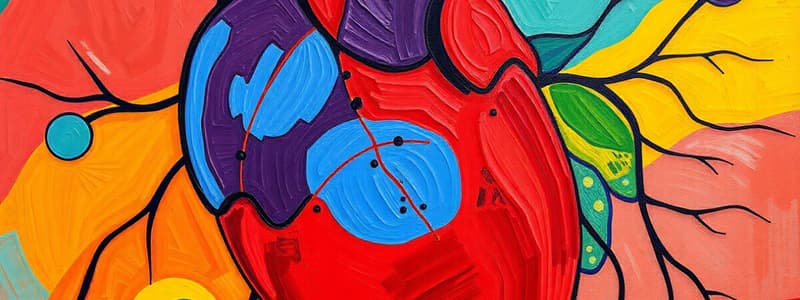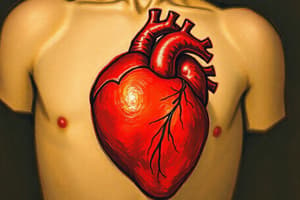Podcast
Questions and Answers
Which component of the heart's conducting system is known for its ability to spontaneously depolarize, setting the pace for the entire system?
Which component of the heart's conducting system is known for its ability to spontaneously depolarize, setting the pace for the entire system?
- Bundle branches
- Atrioventricular (AV) node
- Sinoatrial (SA) node (correct)
- Purkinje fibers
What is the approximate duration of the cardiac muscle action potential?
What is the approximate duration of the cardiac muscle action potential?
- 1.0 second
- 0.1 second
- 0.3 seconds (correct)
- 1.5 seconds
What is the role of the funny sodium channels in autorhythmic cells?
What is the role of the funny sodium channels in autorhythmic cells?
- Initiate rapid repolarization
- Prevent any ion movement across the cell membrane
- Maintain a stable resting membrane potential
- Cause the RMP to move towards the threshold (correct)
During which phase of the cardiac action potential are the fast Na+ channels primarily open?
During which phase of the cardiac action potential are the fast Na+ channels primarily open?
What prevents tetanus (sustained contraction) in cardiac muscle?
What prevents tetanus (sustained contraction) in cardiac muscle?
Which of the following best describes the role of gap junctions in the heart's conducting system?
Which of the following best describes the role of gap junctions in the heart's conducting system?
What is the primary event that occurs during the plateau phase (step 2) of the cardiac action potential?
What is the primary event that occurs during the plateau phase (step 2) of the cardiac action potential?
Which of the labeled waves on an ECG corresponds to ventricular repolarization?
Which of the labeled waves on an ECG corresponds to ventricular repolarization?
In a healthy heart, if the SA node is damaged, which of the other components is most likely to take over as the heart's pacemaker?
In a healthy heart, if the SA node is damaged, which of the other components is most likely to take over as the heart's pacemaker?
What triggers the release of more calcium from the sarcoplasmic reticulum (SR) during cardiac muscle contraction?
What triggers the release of more calcium from the sarcoplasmic reticulum (SR) during cardiac muscle contraction?
Which segment on the ECG represents the time from the start of atrial excitation to the start of ventricular excitation?
Which segment on the ECG represents the time from the start of atrial excitation to the start of ventricular excitation?
What is the approximate resting membrane potential (RMP) of a cardiac cell?
What is the approximate resting membrane potential (RMP) of a cardiac cell?
After the cardiac muscle action potential, why is relaxation important before a new cycle starts?
After the cardiac muscle action potential, why is relaxation important before a new cycle starts?
In cardiac cells, where are calcium voltage-gated channels located?
In cardiac cells, where are calcium voltage-gated channels located?
How do Purkinje fibers facilitate rapid transmission of electrical signals in the ventricles?
How do Purkinje fibers facilitate rapid transmission of electrical signals in the ventricles?
Which ion is at a higher concentration in the extracellular fluid compared to the intracellular fluid of cardiac muscle cells?
Which ion is at a higher concentration in the extracellular fluid compared to the intracellular fluid of cardiac muscle cells?
What is the function of the AV node slowing down the electrical signal?
What is the function of the AV node slowing down the electrical signal?
Which of the following is NOT a step involved in the cardiac muscle action potential?
Which of the following is NOT a step involved in the cardiac muscle action potential?
What is the typical rate of action potential generation in the AV node?
What is the typical rate of action potential generation in the AV node?
What would be the effect of a drug that blocks potassium channels in cardiac muscle cells?
What would be the effect of a drug that blocks potassium channels in cardiac muscle cells?
Which structural component facilitates fast transmission without contraction and has numerous gap junctions?
Which structural component facilitates fast transmission without contraction and has numerous gap junctions?
Which of the following is responsible for maintaining depolarization in cardiac cells to allow contraction to occur?
Which of the following is responsible for maintaining depolarization in cardiac cells to allow contraction to occur?
Where is the AV node located in the heart?
Where is the AV node located in the heart?
Why is atrial repolarization not seen as a separate wave on a typical ECG?
Why is atrial repolarization not seen as a separate wave on a typical ECG?
Which factor contributes to the instability of the resting membrane potential (RMP) in autorhythmic cells?*
Which factor contributes to the instability of the resting membrane potential (RMP) in autorhythmic cells?*
Flashcards
Conducting System
Conducting System
Specialized cardiac muscle fibers controlling signal transmission through the heart.
Autorhythmic
Autorhythmic
The ability of cardiac cells to spontaneously depolarize.
Gap Junctions
Gap Junctions
Varying densities in the heart that allow electrical signals to pass.
Sinoatrial (SA) Node
Sinoatrial (SA) Node
Signup and view all the flashcards
Interatrial Septum
Interatrial Septum
Signup and view all the flashcards
Atrioventricular (AV) Node
Atrioventricular (AV) Node
Signup and view all the flashcards
AV Bundle (Bundle of HIS)
AV Bundle (Bundle of HIS)
Signup and view all the flashcards
Bundle Branches
Bundle Branches
Signup and view all the flashcards
Purkinje Fibers
Purkinje Fibers
Signup and view all the flashcards
Cardiac RMP
Cardiac RMP
Signup and view all the flashcards
Pacemaker Potential
Pacemaker Potential
Signup and view all the flashcards
Step 1: Rapid Depolarization
Step 1: Rapid Depolarization
Signup and view all the flashcards
Step 2: Maintained Depolarization
Step 2: Maintained Depolarization
Signup and view all the flashcards
Refractory Period
Refractory Period
Signup and view all the flashcards
Calcium-Induced Calcium Release (CICR)
Calcium-Induced Calcium Release (CICR)
Signup and view all the flashcards
Step 3: Repolarization
Step 3: Repolarization
Signup and view all the flashcards
Electrocardiogram (ECG/EKG)
Electrocardiogram (ECG/EKG)
Signup and view all the flashcards
P Curve
P Curve
Signup and view all the flashcards
QRS Complex
QRS Complex
Signup and view all the flashcards
T Curve
T Curve
Signup and view all the flashcards
PQ(PR) Segment
PQ(PR) Segment
Signup and view all the flashcards
QT segment
QT segment
Signup and view all the flashcards
Autorhythmic MAPs: SA Node
Autorhythmic MAPs: SA Node
Signup and view all the flashcards
Autorhythmic MAPs: AV Node
Autorhythmic MAPs: AV Node
Signup and view all the flashcards
Autorhythmic and contractile
Autorhythmic and contractile
Signup and view all the flashcards
Study Notes
Conducting System
- Specialized cardiac muscle fibers transmit signals through the heart.
- These fibers are autorhythmic, meaning they can spontaneously depolarize.
- Gap junctions vary in density depending on the region.
- Sarcolemma have various ion channel diameters depending to change ion movements.
- Signals are altered at various points on the pathway.
- Nodes consist of a lump or mass of specialized cardiac cells.
- The sinoatrial (SA) node is the first action potential (AP) generator.
- The SA node is located near the opening of the superior vena cava in the right atrium.
- The SA node depolarizes the fastest, setting the AP firing pace.
- The interatrial septum carries signals to the left atrium.
- The atrioventricular (AV) node is the second AP generator.
- The SA node overrides the AV node but the AV node will set the pace if the SA node malfunctions.
- The AV node slows the signal down in the interatrial septum near the coronary septum and AV valve.
- The AV node has smaller fibers and fewer gap junctions compared to the SA node.
- The AV bundle (bundle of His) carries signals through a small hole in the fibrous skeleton to reach the ventricles.
- Bundle branches consist of left and right branches with more gap junctions and a larger diameter than the AV node.
- Bundle branches extend beneath the endocardium and through the interventricular septum to the apex of the heart.
- Purkinje fibers are bundle branches that fold back up and travel along the outside of the ventricles.
- Purkinje fibers have a larger diameter but fewer myofibrils for fast transmission without contraction and have many gap junctions.
- The heartbeat occurs because of autorhythmic (create and transmit APs) and contractile (most) fibers.
Cardiac MAPs
- Cardiac resting membrane potential (RMP) is approximately -90 mV.
- Extracellular fluid has high [Na+] and [Ca2+], while intracellular fluid has high [K+].
- Step 1 involves rapid depolarization to ~20 mV.
- Voltage-gated fast Na+ channels open, causing Na+ inflow during rapid depolarization.
- Step 2 involves maintained depolarization to allow contraction (cusp then plateau).
- Voltage-gated slow Ca2+ and some K+ channels open, while Na+ channels close during maintained depolarization.
- Troponin can receive Ca2+ from the sarcoplasmic reticulum (SR) or from extracellular fluid.
- Calcium-induced calcium release (CICR) involves specialized receptors on the SR releasing more Ca2+ after the initial release.
- Calcium voltage-gated channels are found all over the sarcolemma.
- Step 3 involves repolarization.
- Ca2+ channels close, and more K+ channels open during repolarization (arccot).
- Cardiac muscle action potential takes about 0.3 seconds in total.
- The refractory period starts at the same time as depolarization and ends slightly after contraction ends, allowing relaxation to prevent tetanus.
- Contraction starts slightly after depolarization.
Autorhythmic MAPs
- The SA node rate is ~100 bpm (70-80*).
- The AV node rate is 60-70 bpm (40-60*).
- Purkinje fibers rate is 25-30 bpm (20-40*).
- The pacemaker will be the AV node if something is wrong with the SA node.
- The pacemaker will be an artificial pacemaker if the AV node fails too, to stimulate depolarization.
- There is no stable RMP; the lower end is -60 mV
- "Funny" sodium channels are non-gated leak-like channels allowing constant Na+ movement into the cell.
- Funny sodium channels widen as the voltage inside the cell becomes more negative below -50 mV.
- Pacemaker potential is caused by Na+ leakage into the cell, causing RMP to move towards the threshold.
- Transient calcium channels start to open as the cell becomes more positive, helping to reach the threshold.
- Potassium channels close during this period.
- During the depolarization phase, long-lasting Ca2+ channels open, and K+ channels are closed.
- During the repolarization phase, Ca2+ channels close, and K+ channels open.
Electrocardiogram
- ECG/EKG measures electrical signals sent through the heart via a series of leads (electrodes) placed on the skin.
- The P curve represents atrial depolarization.
- The P curve is a small bell curve.
- The QRS complex represents ventricular depolarization (and atrial repolarization).
- The QRS complex is identified as a dramatic dip (Q), a rise (R), and a bigger dip (S).
- The T curve represents ventricular repolarization.
- The T curve is a medium, right-leaning bell curve.
- The PQ (PR) segment indicates the start of atrial excitation to the start of ventricular excitation, lasting ~0.16 s.
- The QT segment indicates the start of ventricular depolarization to the end of ventricular repolarization, lasting ~0.36 s.
Studying That Suits You
Use AI to generate personalized quizzes and flashcards to suit your learning preferences.





